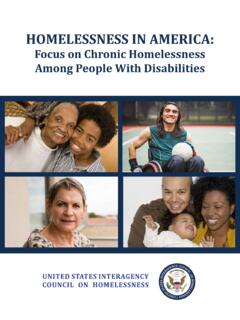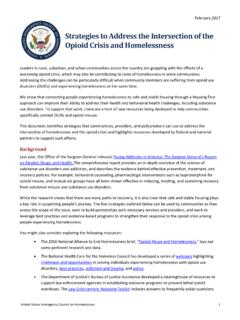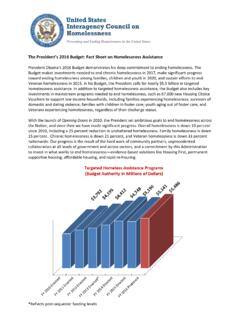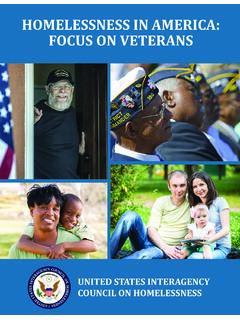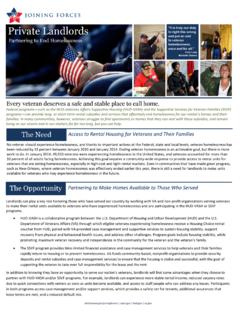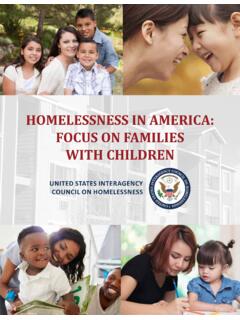Transcription of 10 Strategies to End Chronic Homelessness
1 Version 1, April 2016 United States Interagency Council on Homelessness 1 10 Strategies to End Chronic Homelessness We can end Homelessness for people with the most complex needs in our communities, including people with disabilities with the most extensive experiences of Homelessness . We know the solution supportive housing and have seen it work across the country. However, ending Chronic Homelessness takes political will, leadership, collaboration, and coordination among multiple state and local programs to align resources for housing and supportive services. To help you do this challenging work, we ve compiled 10 Strategies you can use to drive progress in your community. We expect to add additional tools and resources to this document in the future. 1. Start at the Top: Get State and Local Leaders to Publicly Commit to and Coordinate Efforts on Ending Chronic Homelessness One of the key lessons we have learned through our work ending Veteran Homelessness is that commitments from, and cross-sector coordination among, state and local leaders and elected officials can create the urgency necessary to achieve an end to Homelessness .
2 The same is true for ending Chronic Homelessness . Governors, mayors, and county leaders can convene the appropriate partners and drive accountability. And they can ensure that strategic planning is coordinated and that health, behavioral health, reentry, and housing policies and resources are available and aligned to scale and deliver supportive housing to achieve this goal. Tool: Developing a State Interagency Council to End Homelessness (USICH) 2. Identify and Be Accountable to All People Experiencing Chronic Homelessness , including People Cycling through Institutional Settings You can t solve a problem you can t see. Solving Chronic Homelessness is only possible if every individual experiencing or at risk of it is located and identified across a variety of settings, and their progress in engagement and housing placement is tracked in real time.
3 To do so, your community should conduct coordinated outreach, implement data-driven targeting by using and cross-referencing data sets ( , HMIS, Medicaid, jail/corrections), and use other methods to identify people experiencing or at risk of experiencing Chronic Homelessness , including people cycling between Homelessness , jails, and hospitals. By tracking engagement efforts at the person-level, such as with an active list, communities can better monitor their progress and hold themselves accountable to quickly helping every individual experiencing Chronic Homelessness . Tools: Connecting People Returning from Incarceration with Housing and Homelessness Assistance Tip Sheet (USICH) How Data is Ending Chronic Homelessness in Maine (USICH) Crisis Indicator: Triage Tool for Identifying Homeless Adults in Crisis (Economic Roundtable) Homeless Emergency Assistance and Rapid Transition to Housing: Defining Chronically Homeless (HUD) Version 1, April 2016 United States Interagency Council on Homelessness 2 The Office of Community Oriented Policing Services (COPS) Newsletter Volume 8 Issue 12: Breaking the Cycle of Homelessness (DOJ) NYC FUSE Evaluation: Decreasing Costs and Ending Homelessness (CSH) Permanent Supportive Housing Resource Guide: Chapter 7 (VA) 3.
4 Ramp up Outreach, In-reach, and Engagement Efforts Persistent, coordinated, and creative outreach efforts and in-reach into institutional settings are vitally important to the ability to not only identify, but engage, people experiencing Chronic Homelessness and link them to the housing and services interventions available in your community. That involves: Ensuring that outreach efforts are comprehensive covering a full geographic area and the multiple settings within it and coordinated across all teams and providers Sharing information across outreach teams and sites, and coordinated with other systems, including law enforcement, hospitals and emergency departments, prisons and jails, libraries, and job centers Partnering with Health Care for the Homeless (HCH) grantees and Projects for Assistance in Transition from Homelessness (PATH)
5 Grantees who can have a powerful impact on improving care coordination and optimizing resources Partnering with law enforcement, prisons, jails, and hospitals to conduct both in-reach and outreach to reduce the cycle between Homelessness and criminal justice system involvement These efforts should seek to reach and connect with all people who are unsheltered within your community, including people living in encampments or tent cities, as well as people in institutional settings, such as jails and hospitals. All outreach should be person-centered and emphasize building rapport and trust as a means of helping people obtain housing with appropriate services. Tools: Ending Homelessness for People Living in Encampments: Advancing the Dialogue (USICH) We Can Break the Cycle of Homelessness and Criminal Justice System Involvement (USICH) Assessing the Evidence: What We Know About Outreach and Engagement (SAMHSA) Projects for Assistance in Transition from Homelessness (PATH) Resource Page: Outreach (SAMHSA) National Health Care for the Homeless Council: Outreach Resources (NHCHC) Law Enforcement is a Critical Component of the Coordinated Effort to End Homelessness (DOJ) 4.
6 Implement a Housing-First System Orientation and Response Communities must adopt a Housing First approach across their entire system to ensure that people with complex needs can exit Homelessness as quickly as possible. To drive such transformation, communities should adopt uniform measures of success that emphasize permanent housing, with the right level of services, as the goal for people experiencing Chronic Homelessness . Other Strategies include: Reducing or removing barriers for applicants with substance use issues, poor credit or financial history, or past involvement with the criminal justice system Coordinating with legal services organization to address individual and systemic legal needs of people experiencing Chronic Homelessness Creating strong and direct referral linkages and relationships between the crisis response system local shelters, outreach programs, hospitals, police departments, etc.
7 And supportive housing Version 1, April 2016 United States Interagency Council on Homelessness 3 Ensuring that all staff in shelters, outreach teams, and housing settings are trained that substance use, criminal histories, or motivation are not obstacles to successful tenancy in housing Tools: Housing First Checklist: A Practical Tool for Assessing Housing First in Practice (USICH) Implementing Housing First in Permanent Supportive Housing (USICH) Landlord Engagement Resources (USICH) Housing First in Permanent Supportive Housing Brief (HUD) Legal Aid Interagency Roundtable Toolkit (DOJ) 5. Set and Hold Partners Accountable to Ambitious Short-Term Housing Placement Goals Many communities have established ambitious monthly, quarterly, or 100-day housing placement efforts, sometimes called housing placement surges, to break down the larger goal of ending Chronic Homelessness into focused blocks of time and effort, while pushing their systems to perform with maximum efficiency and better outcomes.
8 These goals can be met by: Creating and sharing a community-wide list of people experiencing Chronic Homelessness Using a tested and validated assessment tool and process to prioritize and target interventions Using navigators and/or guides to address individual s needs Monitoring progress rooted in access to housing on a weekly or monthly basis Tools: Connecticut Launches 100-Day Effort to End Homelessness (USICH) A Sea Change in Fresno s Homelessness Crisis Response (USICH) Coordinated Entry System to End Veteran and Chronic Homelessness in Tucson (USICH) 6. Prioritize People Experiencing Chronic Homelessness in Existing Supportive Housing In many communities, the supportive housing opportunities that have been created have unfortunately not been well targeted. In fact, national data shows that only about 29% of existing supportive housing is targeted to individuals experiencing Chronic Homelessness .
9 You can maximize the impact of existing supportive housing by adopting a policy that prioritizes individuals experiencing Chronic Homelessness for any newly created units, and for any units that become available through turnover, unless there are no longer any individuals experiencing Chronic Homelessness remaining. Coordinated entry is a critically important approach for prioritizing and matching people experiencing Homelessness to the most appropriate housing and services. Within coordinated entry systems, communities can use data-driven approaches to prioritize people experiencing Chronic Homelessness who have the most significant needs for housing and services. Tools: Notice on Prioritizing Persons Experiencing Chronic Homelessness and Other Vulnerable Homeless Persons in Permanent Supportive Housing (HUD) Permanent Supportive Housing Resource Guide (VA) Coordinated Entry Policy Brief (HUD) Version 1, April 2016 United States Interagency Council on Homelessness 4 Lessons Learned from Developing Coordinated Entry Systems: Richmond and Los Angeles (USICH) Homeless Emergency Assistance and Rapid Transition to Housing: Defining Chronically Homeless (HUD) Final Chronic Definition Adds Flexibility, Inclusiveness, and Specificity (USICH) 7.
10 Project the Need for Additional Supportive Housing and Reallocate Funding to Take It to the Scale Needed To end Chronic Homelessness , communities must have an adequate supply of supportive housing to assist individuals who are currently experiencing Chronic Homelessness and those who are likely to be chronically homeless in the near future. Some communities can make significant progress toward the goal just by improving the targeting of existing units. Most communities will also need to expand their supportive housing inventory through maximizing both targeted grants and leveraging new mainstream resources. The degree to which resources meet this current and future need will vary from community to community. A good starting point is to use data to assess whether your community has a gap in supportive housing availability, and if so, to determine the size of that gap.
